Atari Program Recorder Model 410 (Boxed)
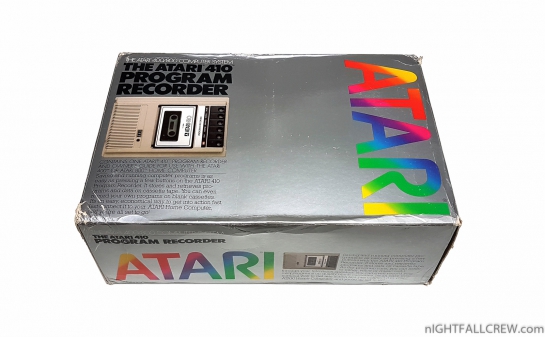
This version of the Atari 410 Cassette Recorder differs from the one inside the “Atari – The Educator” box only for the additional colored box that hold the simple one in white cardboard.
Gallery:

This version of the Atari 410 Cassette Recorder differs from the one inside the “Atari – The Educator” box only for the additional colored box that hold the simple one in white cardboard.
Gallery:

Commodore CBM 8032 (HP – Early version 1980) – CompuThink Disk Drive Controller – External Dual Disk Drive – Woltron ROM-BUS Adapter.
Unfortunately there is no documentation on the net of this Computhink card that seems to be a prototype or a clone, also there is no documentation or photos of the BUS/ROM Adapter by Woltron.
I spent sleepless nights looking for the starting SYS for the disk management software on the eprom, i have disassembled 24k of code (C-DOS Roms / Basic Roms Patched / Edit Roms Patched) in machine language.
I did it and found it the starting sys ($E790 – SYS 59280), although everything seems to work perfectly after the sys command is printed on the screen (*DOS-40*) and by typing the directory command ($d,1) or the format command ($f,1) the floppy starts to run correctly but the head does not move, while the exit command ($h) work correctly,
i need to say that i replaced the FDC1791 and some floppy disk logic and also one floppy disk drive, but nothing changed.
My suspicion falls on the PROM 82S123 there is no dump on the net, reading this PROM of 32 bytes, only the first 8 Bytes are filled, this is right ? we’ll never know.
All EPROM and PROM have been dumped and you can find them in the archive below.
Gallery:
Download: C-DOS 4.0 - Basic/Edit Roms Patched - PROM 82S123 (1057)
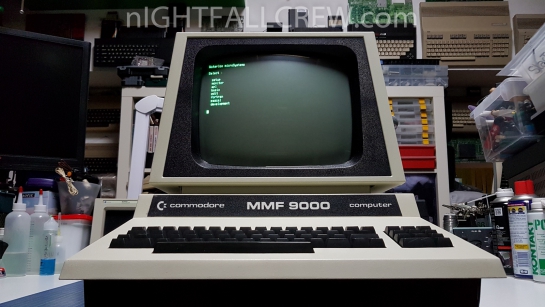
The SuperPET is a Commodore PET 8032 with one or two added boards that were designed at the University of Waterloo.
The computer has a built-in RS-232C interface and many programming languages on Floppy Disk. In Europe, this machine was called the MicroMainFrame 9000, or MMF 9000.
Let’s start to assembling the BMB Compuscience Ltd Board and Compu-Think 64K Memory Expansion board in the Commodore MMF 9000 (SuperPET)
I had to shorten the original standoffs installed in the computer because the length was wrong for the two boards BMB Compuscience/Compu-Think 64K. The long standoffs are used for the superPET Combo Board (the last one released).
It was not a simple job, obviously i have looked around for the identical standoffs with thickness, size, pitch and some with a long screw other with a short screw.
Between one phase and another i have also giving a nice clean inside and outside of the computer and of the motherboard.
Unfortunately there are a couple of problems after assembling the two boards of the MMF 9000 (SuperPET).
Defects:
Repair/Fix:
About the programs that don’t runs in the 6809 environment the repair was a bit longer. I have used the only program that worked under the 6809 environment, the Machine Language Monitor.
With this program i have filled the memory with the command Fill (f 9000-9fff aa) and i have changed from time to time the bytes that i was going to write in memory and i have used the command (d 9000-) to see the results and not all memory locations are written correctly.
With the Bank Switching command (b 0, b 1 …) i have switch the memory bank, there are 16 banks of 4k each for a total of 64k.
I have found 7 x 4116 RAM failed (this card is new, never used), replaced these bad RAMs everything has started to work properly.
So my advice is to try to load the Waterloo software in the 6809 environment to make sure that the 64k memory expansion (only seen in the 6809 environment) is working properly.
Below the photos of all the tests that i have done:
Gallery:
This is a archive with documents, disk images and rom files usefully to test the computer.
Download: MMF9000/SuperPET Documents,Disk images,ROM Files (1349)
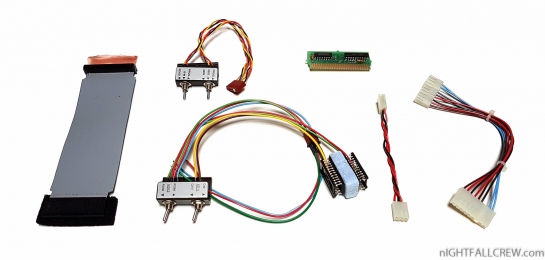
Commodore SuperPET (SP9000/MMF9000) Accessories & Motherboard KIT for Replacement (NOS)
This is a New Old Stock (NOS) Kit from Commodore sold as spare parts for the Commodore SuperPET (SP9000/MMF 9000). We are talk about the early model of the SuperPET the one with two internal motherboards (sandwich) and four external switches.
Motherboards and Accessories have never been used, both they are in a perfect state.
The kit includes:
In the photos you can also see another Commodore BMB Compuscience Ltd Board with the same ASSY but without some eproms. This motherboard is new and never used like the previous one.
With this KIT i can finally complete my Commodore SuperPET without the two motherboards and accessories to get a SuperPET and not a simple Commodore 8032 with a SuperPET label ;-)
Gallery:
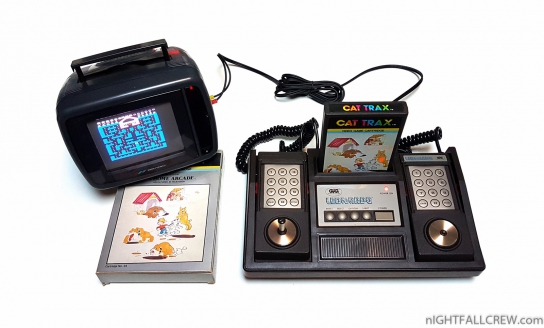
The Leonardo console is nothing more than a italian clone distributed by “Gig” of the console Emerson Arcadia 2001. 35 games have been published under the GIG Leonardo label.
Arcadia 2001 is a second-generation 8-bit console released by Emerson Radio in 1982 following the release of ColecoVision. It was discontinued only 18 months later, with a total of 35 games having been released. Emerson licensed the Arcadia 2001 to Bandai, which released it in Japan. Over 30 Arcadia 2001 clones exist.
The unrelated Arcadia Corporation, manufacturer of the Atari 2600 Supercharger add-on, was sued by Emerson for trademark infringement. Arcadia Corporation then changed its name to Starpath.
The Arcadia is much smaller than its contemporary competitors and is powered by a standard 12-volt or 9-volt power supply so it can be used in a boat or a vehicle. It also has two outputs (or inputs) headphone jacks on the back of the unit, on the far left and far right sides.
The system came with two Intellivision-style controllers with a 12 button keypad and ‘fire’ buttons on the sides. The direction pads have a removable joystick attachment. Most games came with BoPET overlays that could be applied to the controller’s keypads. The console itself had five buttons: power, start, reset, option, and select.
There are at least three different types of cartridge case styles and artwork, with variations on each. Emerson-family cartridges come in two different lengths (short and long) of black plastic cases.
Technical specifications:
Gallery:
source: wikipedia
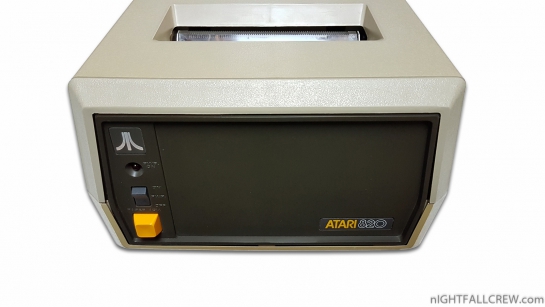
The Atari 820 printer provided Atari 400/800 users with a quick and simple printer. No drivers or special interfaces were needed.
The Atari 820 printer plugged directly onto the Atari SIO bus and allowed users the ability to make 40 column printouts which were good for tracking finances, printing out program listings and other files. The printer made an interesting sound which could only be described as a washing machine.
Gallery:
source: atarimuseum.com
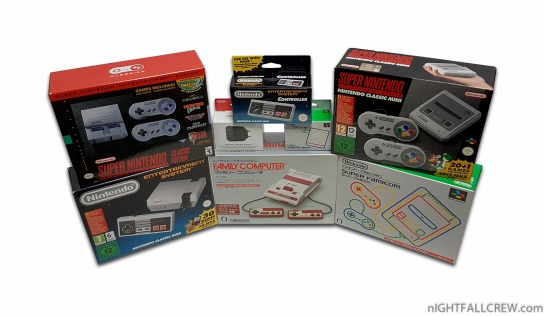
Complete collection of Nintendo Classic Mini & Accessories.
There is not much to say about this photo, i love Nintendo and i wanted all versions of Nintendo Classic Mini.
Gallery:
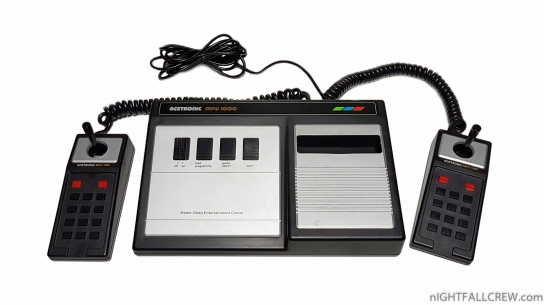
The 1292 Advanced Programmable Video System (Acetronic MPU-1000) is a home video game console released by European company Audiosonic in 1978.
It is part of a group of software-compatible consoles which include the Interton VC-4000 and the Voltmace Database. The 1292 Advanced Programmable Video System included its power pack inside the console instead of an exterior power pack.
Specifications:
Graphics:
Misc:
User programming:
An expensive (£49 in the UK in 1977) Hobby Module was available which gave 6.5 kb of user-programmable memory and had a 5 pin DIN socket to allow software to be saved to a cassette tape player.
This converted the unit into a halfway house between a home computer and an ordinary gaming console.
The user had to be familiar with programming in Signetics 2650 assembly language and the unconventional ways and register architecture of the Signetics 2650 processor. For example, on many other processors an opcode 0 indicates “no operation” whereas on the 2650 it instructs the processor to Branch To Address In Immediate Register B.
This was a source of many software debugging hassles for budding home programmers.
Gallery:
source: wikipedia
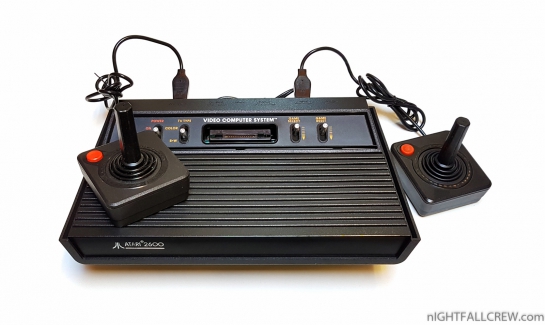
The Atari 2600 (or Atari Video Computer System before November 1982) is a home video game console by Atari, Inc. Released on September 11, 1977, it is credited with popularizing the use of microprocessor-based hardware and ROM cartridges containing game code, a format first used with the Fairchild Channel F video game console in 1976. This format contrasts with the older model of having non-microprocessor dedicated hardware, which could only play the games that were physically built into the unit.
For five years, 1977 until late 1982, the system was officially sold as the Atari VCS, an abbreviation for Video Computer System. Following the release of the Atari 5200 in November 1982, the VCS was renamed to the “Atari 2600″, after the unit’s Atari part number, CX2600. The 2600 was typically bundled with two joystick controllers, a conjoined pair of paddle controllers, and a game cartridge: initially Combat, and later Pac-Man.
Gallery:
source: wikipedia

A paddle is a game controller with a round wheel and one or more fire buttons, where the wheel is typically used to control movement of the player object along one axis of the video screen.
A paddle controller rotates through a fixed arc (usually about 330 degrees); it has a stop at each end.
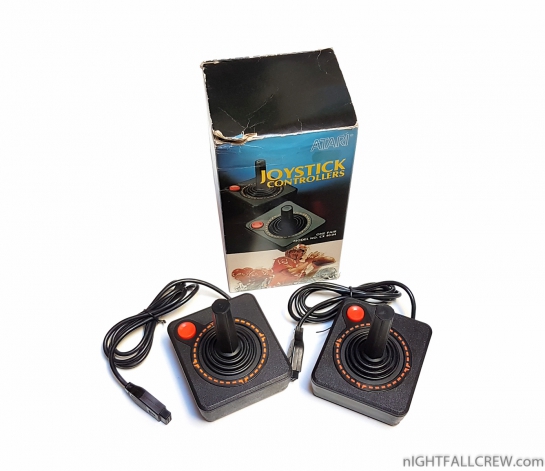
The Atari CX40 joystick was the first widely used cross-platform game controller. The original CX10 appeared on the Atari 2600 in 1977, and was considered such a great advance over other controllers that it became the primary input device for most games on the platform. The CX10 was replaced after a year by the much simpler and less expensive CX40. The addition of the Atari joystick port to other platforms cemented its popularity, and millions were produced and used on almost every game console and home computer of the era.
The CX40 was so popular during its run that it became as iconic for Atari as its “Fuji” it remains a common staple in video game iconography to this day, and is commonly referred to as the symbol of 1980s video game system design. The CX40 has been called “the pinnacle of home entertainment controllers in its day”, and remains a staple of industrial design discussions.
source: wikipedia

Of all of the Joysticks Atari ever made over the years they were in business, our two least favorite Atari controllers were the 7800 CX24 Slim line Deluxe Joystick (sometimes called the Atari Proline Joystick) and the ill fated Atari Space Age Joystick, which had an internal flex circuit problem from the start and caused it to be dropped by Atari very fast. Now Atari Space Age Joysticks are a very rare Atari collector item.
The main reason why the Atari CX24 dual fire button Joystick was not one of our favorite Atari controllers made, was the left, right fire button PCB’s and Main X / Y PCB would fail very fast. 1st the left and right fire buttons PCBs would fail and second the main X / Y PCB would fail next with any kind of normal use.
You can read more about this joystick here
Recent Comments